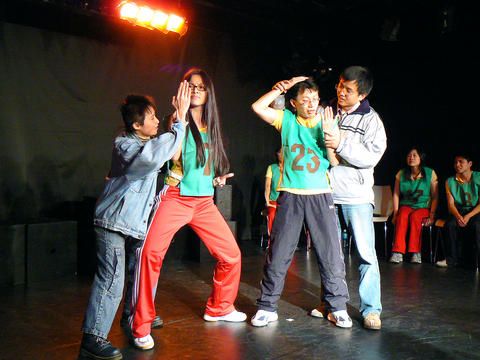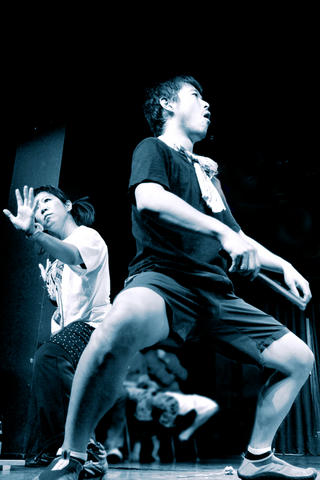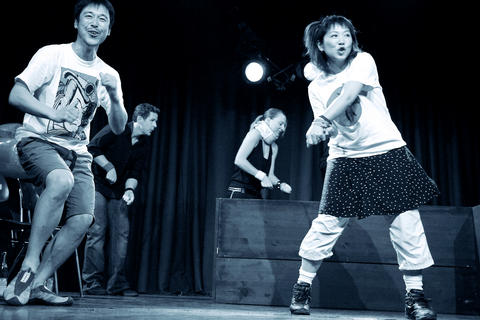Ever felt like yelling out in a theater performance, but were too afraid? Or felt that shouting out your opinion was inappropriate or rude? Well beginning tonight at The Mayor's Residence Art Salon prepare for a performance in which the audience can become the actor and passive spectators are frowned upon.
"I always emphasize [to the audience] that in this show we work together," said Taiwan's Guts Improv Theater (勇氣即興劇場) founder and this weekend's Theatersports' emcee Wu Hsiao-hsien (吳效賢), referring to the relationship between audience and actors.
It's a sentiment shared by Japan's Impro Works and Hong Kong's Champion Arts Association (青皮人藝術合作社), the other two companies that have come to Taiwan to compete in the Theatersports contest.

PHOTOS: COURTESY OF GUTS IMPROV THEATER
"Competition is just the format," said Shirley Chan (陳明慧) of Champion Arts. "We are still working together and we are playing." Though it"s cloaked in competitiveness, the purpose of the performance is to suck the audience into the action on stage, turning them into creators as well as observers.
Let's rumble
Theatersports is a performance style that finds its origins in improvisational theater (improv or impro, depending on the dictionary you use) and stresses the importance of the audience's active participation. It involves two different formats: long and short. Short form is more competitive in the sense that two teams take the stage at the same time. The long form involves one team and lasts for 30 minutes. This weekend's performances will be held in English and Chinese.

PHOTO: COURTESY OF GUTS IMPROV THEATER
Though each improv company approaches Theatersports in a slightly different manner, the basic format includes teams of actors - professional or otherwise - performing in front of judges while an emcee implores the audience to shout out their ideas, suggestions and criticisms, particularly to the judges.
"In Japan, the judges' status [in society] is very high, so it is seen as very rude to criticize them. So I explain before the performance begins that judges are supposed to encourage the audience to criticize them," said Yuri Kinugawa, art director of Japan's Improv Works.
Champion Arts Association uses a different format. "We ask the audience to be the judges. We will explain [the format] before the show and ask for suggestions because that will involve more [of the] audience. Though some audience members really don't want to get involved in the performance or even give any suggestions, they are always willing to give marks," said Chan.

PHOTO: COURTESY OF GUTS IMPROV THEATER
The Taipei competition will employ three judges and suggestions will come from the audience.
Communicating with the audience members and making it clear they are to be active participants, the three companies agree, remains the biggest obstacle confronting Theatersports in Asia.
Cultural obstacles?
"Because there are conceptual and cultural differences here, it is necessary for the audience to gain an understanding of what they are going to encounter on the stage and that, yes, they are going to be participants," Chan said.
She added that audiences in Hong Kong are so used to traditional theater they often remain silent in the theater, even though the emcee is imploring them to speak up. "It is very different from what we have seen ... in Canada and the US, where the audience members will shout and scream and get involved," Chan said.
Still, with an energetic emcee on the mic, even the most reticent of crowds may turn from speechless statues to raucous participants.
"You (the audience) make the show, it's not just us performing for you. We need your input to complete this show," Wu said.
It's an attitude that should keep the audience members on the edge of their seat.

This is the year that the demographic crisis will begin to impact people’s lives. This will create pressures on treatment and hiring of foreigners. Regardless of whatever technological breakthroughs happen, the real value will come from digesting and productively applying existing technologies in new and creative ways. INTRODUCING BASIC SERVICES BREAKDOWNS At some point soon, we will begin to witness a breakdown in basic services. Initially, it will be limited and sporadic, but the frequency and newsworthiness of the incidents will only continue to accelerate dramatically in the coming years. Here in central Taiwan, many basic services are severely understaffed, and

Jan. 5 to Jan. 11 Of the more than 3,000km of sugar railway that once criss-crossed central and southern Taiwan, just 16.1km remain in operation today. By the time Dafydd Fell began photographing the network in earnest in 1994, it was already well past its heyday. The system had been significantly cut back, leaving behind abandoned stations, rusting rolling stock and crumbling facilities. This reduction continued during the five years of his documentation, adding urgency to his task. As passenger services had already ceased by then, Fell had to wait for the sugarcane harvest season each year, which typically ran from

It is a soulful folk song, filled with feeling and history: A love-stricken young man tells God about his hopes and dreams of happiness. Generations of Uighurs, the Turkic ethnic minority in China’s Xinjiang region, have played it at parties and weddings. But today, if they download it, play it or share it online, they risk ending up in prison. Besh pede, a popular Uighur folk ballad, is among dozens of Uighur-language songs that have been deemed “problematic” by Xinjiang authorities, according to a recording of a meeting held by police and other local officials in the historic city of Kashgar in

It’s a good thing that 2025 is over. Yes, I fully expect we will look back on the year with nostalgia, once we have experienced this year and 2027. Traditionally at New Years much discourse is devoted to discussing what happened the previous year. Let’s have a look at what didn’t happen. Many bad things did not happen. The People’s Republic of China (PRC) did not attack Taiwan. We didn’t have a massive, destructive earthquake or drought. We didn’t have a major human pandemic. No widespread unemployment or other destructive social events. Nothing serious was done about Taiwan’s swelling birth rate catastrophe.